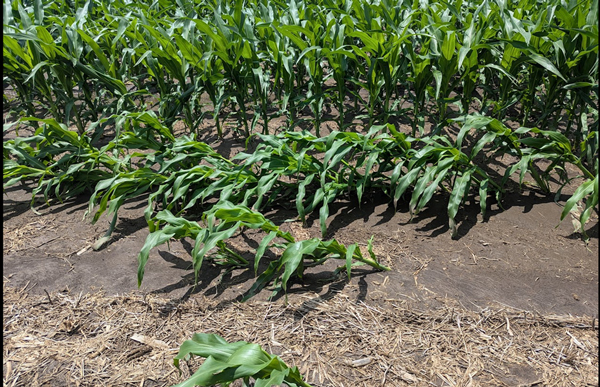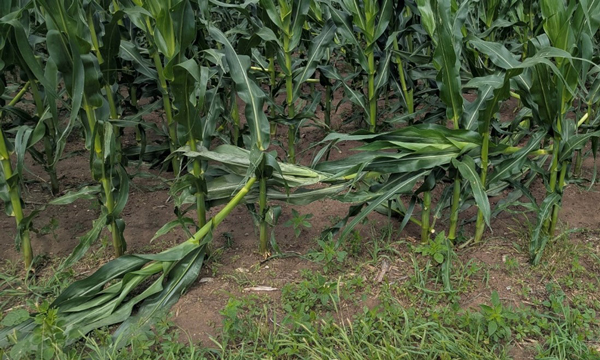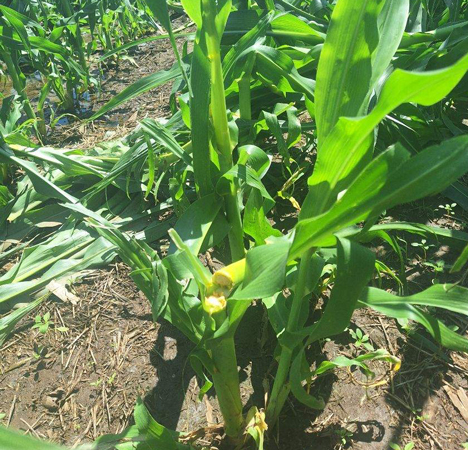Some of the storms and extremely high winds this week have caused leaning and significant stalk breakage in corn fields in some areas of the state. In these kinds of storms, it is not unusual to have a significant portion of plants leaning over or broken off somewhere along the stalk in some fields. When corn leans over or is flattened without stalk breakage, we refer to it as “root lodging”. When stalks are broken, we usually refer to it as “green snap”.
Root lodging (Figure 1): This typically occurs when strong winds pull the roots on one side partway out of the soil, and most often occurs when the soil is saturated and soft. If root lodging occurs early, plants usually recover or stand back up at least partly. This will usually appear as a response and results in the characteristic gooseneck bend in the lower stalk with new brace roots providing above-ground support.

Figure 1. Root lodging due to the high winds. Photo by Tina Sullivan, K-State Research and Extension.
Green snap (Figure 2): This typically occurs when high winds cause stalks to break or snap as corn is rapidly growing (V8 to tassel) in the two- or three-week period from late vegetative until silking. In this case, the stalks have enough height to catch more wind and are also typically more brittle and susceptible to breakage during this period.


Figure 2. High wind during V8 to tassel can result in green snap. These photos were taken in south central Kansas around mid-June 2025. Photos courtesy of Tina Sullivan and Sarah Lancaster, K-State Research and Extension.
Factors influencing root lodging and green snap
A number of factors can affect the severity of root lodging and green snap. Anything that contributes to rapid, vigorous growth may make corn more susceptible to this problem. Often, our best management practices for corn (i.e., high N fertilizer rates, rotation after soybeans, higher plant density promoting early competition with faster elongation and thinner stalks) can contribute to the severity of damage. Although no hybrid is immune to the problem, some hybrids are more susceptible to root lodging or green snap than others. Timing also has a huge impact on the severity of damage, with much less damage in younger corn or in fields that have tasseled and flowered. Fields with younger, shorter corn are more likely to see root lodging than green snap.
What are the implications?
When root lodging occurs early, there may be little or no impact on yield. However, when corn is leaned over later in the season, some yield decrease should be expected due to partial loss of root activity and reduced light interception. Lodging during pollination may severely interfere with fertilization and significantly reduce kernel set. While corn may recover from early root lodging, though with a characteristic goose-necked stalk, it may be more susceptible to lodging at maturity.
In the case of green snap, there is no hope for recovery. However, the corn ear may develop normally if the stalk breaks above the primary ear node. Even with stand loss from green snap, the yield loss may not be proportional to the stand loss. When green snap occurs before tasseling, surviving plants could respond by increasing ear size, final kernel weight, or even by setting additional ears. With 10% or fewer broken stalks, it may be hard to detect a significant yield loss if stands were adequate before the storm.
Research conducted in Minnesota, Nebraska, and Iowa shows that yield loss due to green snap ranged from 0.5 to 1.0% for every 1% stand loss. Yield loss was least severe when stalks broke above the primary ear and greatest when stalks broke below the ear from V12 to the tassel. Research conducted by North Dakota State University further showed the response of corn yields to green snap at V12, V15, and V18 (Table 1). If stalks are broken off below the primary ear, the lower the break, the better. This will allow neighboring plants to take advantage of increased light resources to flex their yield components upwards and partially compensate for the lost plant.
In a 4-year study at Garden City, Kansas, irrigated corn stands were thinned 0, 25, 50, and 75% at V5, V8, V11, and V14 to simulate plant removal by hail. A 25% reduction in stand did not reduce yield when conducted even as late as V11. This was due to the remaining plants having a combination of increased ears per plant, increased kernel number, and increased kernel weight. Observed yield losses across all treatments in the study were always less than a 1:1 relationship with plant removal, thus highlighting the yield plasticity that does exist in corn.
Table 1. Corn yield reduction (%) from three levels of green snap occurrence at three growth stages. Data courtesy of North Dakota State University Extension.
|
Green snap occurrence (%) |
Growth stage when damage occurred |
||
|
V12 |
V15 |
V18 |
|
|
–––––––––––––––––––––– Yield reduction –––––––––––––––––––––– |
|||
|
25 |
11% |
10% |
14% |
|
50 |
14% |
23% |
30% |
|
75 |
27% |
37% |
48% |
Action plans
- Significant root lodging or green snap may reduce canopy cover and the capacity of the crop to suppress weeds. It is important to consider what herbicides have been applied, especially residual products, and consider the need for follow-up applications to control weeds in the absence of crop canopy.
- If stand losses are very severe, there may still be an opportunity to harvest the worst areas for forage. It is also not too late to terminate stands to plant sunflower, soybeans, or grain or forage sorghum. However, these options may be limited by the herbicide program used on the damaged corn crop.
Logan Simon, Southwest Area Agronomist
lsimon@ksu.edu
Tina Sullivan, Northeast Area Agronomist
tsullivan@ksu.edu
Lucas Haag, Northwest Area Agronomist
lhaag@ksu.edu
Tags: corn lodging green snap high winds